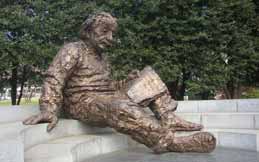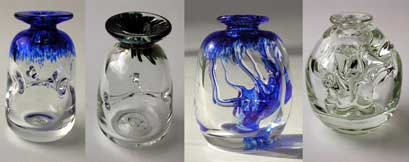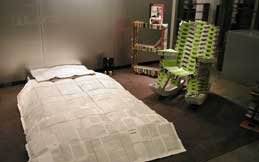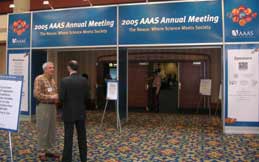
Mathematics at the 2005 AAAS Meeting
 |  |
| Over 9000 people attended the annual meeting of the American Association for the Advancement of Science (AAAS) February 17-21 in Washington, DC. Descriptions of some of the mathematics-related events follow.
| |
Awards
Rhonda Hughes, the Helen Herrmann Professor of Mathematics at Bryn Mawr College, received the 2004 AAAS Mentor Award for Lifetime Achievement. Hughes was honored "for her substantial contributions to mentoring students form underrepresented groups and [for her] leadership in promoting doctoral careers for underrepresented groups, especially women, in mathematics." In her acceptance speech, Hughes said that she shared the award with two Sylvias: her mother, and Sylvia Bozeman of Spelman College, who she said helped her take her mentoring to a whole different level. Hughes also stated that undergraduates "never cease to surprise, amaze, and thrill me." She said that she believed that even at the undergraduate level, it is not possible to say who will be good at mathematics, because even those who initially struggle may still persevere, so that mathematics teachers should "throw the doors open to all, and welcome them with open arms."
Eric Lander, one of the leaders of the Human Genome Project, received the 2004 AAAS Award for Public Understanding of Science and Technology. Lander has a Ph.D. in mathematics and is founding director of the Broad Institute of MIT and Harvard.
Mathematics Meets Origami, Art, Puzzles and Magic: Fun with Algorithms, Erik Demaine, MIT
 |  |
The large audience for this topical lecture did indeed have fun with algorithms as Demaine talked about algorithms in several entertaining situations. He spoke about the computational intractability of Tetris (the proof of which earned him the title of Tetris Master); the beauty of algorithms related to glass-blowing, hinged dissections and building with books; and demonstrated some magic tricks. In one category of tricks, Demaine obtained unexpected shapes by folding paper and making only one cut. The other type of trick required volunteers from the audience. and was equivalent to hanging a picture on n nails and looping the string used to hang the picture in such a way that if any one of the nails was removed, the picture would fall. Designing the latter tricks used topology, algebra, and monotone function theory. (Above photos by Erik Demaine. Glass sculpture by Martin Demaine. Furniture built by MIT students from disused books.)
Mathematics and Human Infectious Disease
Speakers at this symposium talked about different diseases and their models. Most of the behavior of the spread of measles through a population is fairly simple to model, but there are still complex dynamics associated with this spread. Geographically, measles spreads in waves, very much like a forest fire. Wavelets are used to analyze the time components of the disease. The measles model doesn't describe the spread of whooping cough, due to the latter's longer incubation period. The traditional Susceptibility-Exposed-Infected-Recovered model does still work, however, to describe the spread of whooping cough in a population. It is hoped that studying these familiar diseases, for which there are lots of data, will help in the analysis of new diseases like SARS or Ebola.
AMS Exhibit
| The AMS hosted an exhibit at the meeting, featuring materials about mathematics. AMS books were on display as were free materials about Society programs and Mathematics Awareness Month, along with the 2005 calendar of Notices covers: "Celebrating 10 Years of Mathematical Imagery," and the "What can I do with a math degree?" poster. Mathematicians, scientists in other disciplines, representatives of government agencies and other organizations, and parents and teachers visited the booth during the meeting. |
Mathematical Oncology: Bridging the Scientific Divide
Despite the vast amount of cancer research, tumor growth isn't modeled very well at all; that is, little is known about how a normal cell becomes cancerous. One thing that that has become clear is that the process is non-linear. Speakers at this symposium noted that accurate models of tumor growth would allow researchers to do experiments which cannot be done in the lab. One researcher used evolutionary game theory in the analysis of the formation and growth of tumors.
Cancer Screening and its Impact on Cancer Mortality
Much of the information in this symposium is best summarized by the title of the opening talk: "Cancer Screening: The Clash of Science and Intuition." The intuition is that screening is beneficial and has saved lives, yet for some cancers the science does not support the intuition. For example, despite the dramatic increase in the U.S. of the use of the PSA test to screen for prostate cancer, prostate cancer death rates have stayed about the same since the 1970s. Furthermore, Dr. Ian Thompson of the University of Texas Health Science Center gave statistics to show that a PSA score of 1.0 is necessary to catch 90% of prostate cancer, but using that score would increase the false positive rate to 60%. (Currently doctors recommend further procedures after a score of 4.0.) One test that has been effective is the PAP test, which has decreased cervical cancer mortality rates. The test works best when it detects cervical pre-cancerous cells. Also in this session, mathematical models of different screening intervals and age recommendations for mammograms were presented. Models were used because it is not feasible to conduct clinical trials to determine new guidelines for mammograms. The models were based on existing mammogram data and patient histories.
Translation by the Numbers
This symposium dealt with automatic (computer) translation of text - a growing need for business and government, and on the Internet. For example, Microsoft has a tremendous backload of documents that it needs translated from English. There is no practical way for the translation to be done by humans. Data-driven machine translators use statistics to learn word and phrase translations. Then word, phrase, and sentence databases are created for future translations. The translators can then use the databases to translate faster. Software "learns" to translate by training on existing documents which have the same meaning but are in different languages. First, paragraphs and sentences are aligned (not a trivial task because often sentences or paragraphs are missing). Then, words are translated by looking for repetitions of the same strings in the two texts. Once the software can translate individual words, it has to learn the logic of the language so it can construct reasonably good sentences. During post-editing human translators examine the machine translation and classify mistakes to improve the translation algorithm. In addition to providing a need for machine translation, the Internet with its wealth of documents also provides the training sets to improve machine translators.
The 2006 AAAS meeting is in St. Louis.
You can also read about mathematics at the 2004, 2003 and 2002AAAS meetings.



